The province of Messina's slogan is Monte e Mare, mountains and seas. Certainly, the province delivers rugged mountain ranges and contrasting coastlines. The Tyrrhenian coast, the northern coastline leading to Palermo, is one of rocky inlets, saltwater lakes, sand dunes and dry gravel-beds; citrus groves are fringed by myrtle, broom and prickly pear. The Ionian coast is a gentler but equally exotic coastline as far south as Taormina, with sandy shores and resorts. Both coasts offer classical sites, stumpy castles, seafood dishes and an enticing hinterland.
Messina, the city
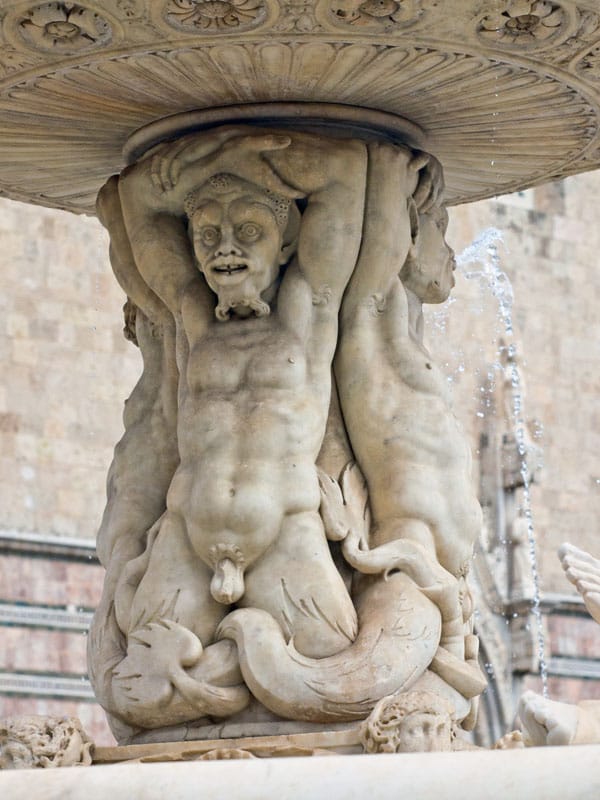
Fountain detail.
Neil Buchan-Grant/APA
Messina 1 [map], settled by the Greeks in 730 BC, was a thriving seafaring power, but one beset by calamities in modern times. The 1908 earthquake killed 84,000 people in 30 seconds, while in 1943 the wartime port represented the Germans’ last stand: the city was devastated and 5,000 people died during Allied bombing. As a result Messina, completely overshadowed by neighbouring Taormina, is designed on a modern grid system and intersected by wide boulevards. Although not instantly appealing, the bustling port, sunken treasures and lively bars make Messina an engaging stop before catching a ferry or touring the coast. The city is poised to learn whether the building of a suspension bridge over the Straits will ever be resumed.
The protectress of the port is the Madonna, the tall statue surmounting the ancient harbour walls of the 16th-century fort, Forte San Salvatore, which protects the inner harbour. Curved around the sickle-shaped harbour is the neglected Cittadella, the 16th-century Spanish bastions and the naval base. The harbour welcomes grey NATO warships docked in deep water and long-prowed feluccas in pursuit of swordfish. Ever-present are the coastguard boats, scouring the Straits for illegal immigrants and drug smugglers. Despite the bustle, the overwhelming feeling is of space and sweeping views.
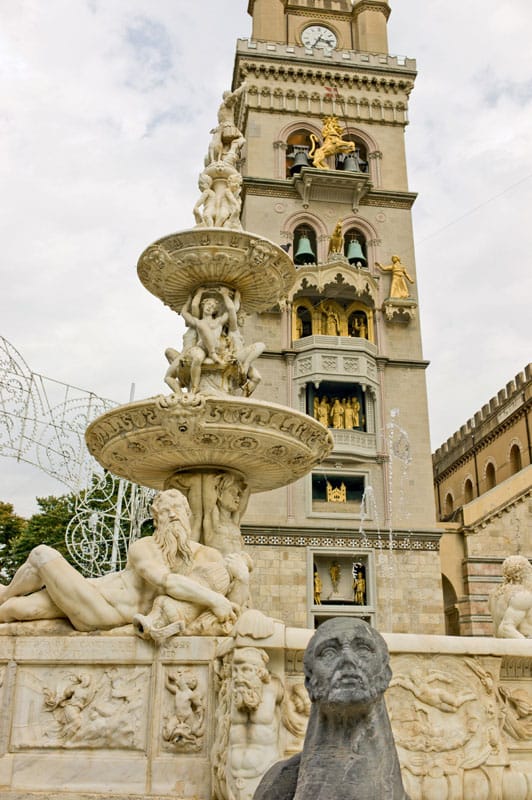
The Orion Fountain and Torre dell'Orologio in Piazza del Duomo, Messina.
Neil Buchan-Grant/APA
Just above the port, the Cattedrale (Mon–Sat 7.15am–7.30pm, Sun until 1.30pm) symbolises the city's survivor mentality: this Norman cathedral has witnessed medieval fires, earthquakes and wartime American firebombing (1943). It is set on a lower level than the surrounding streets that were redeveloped after the 1908 earthquake, when the cathedral was shattered, its 26 granite columns reduced to rubble and its ceiling collapsed. The sculpted main portal and part of the Gothic facade are original, while the harmonious interior features a painted wooden ceiling, 14th-century mosaics in the semicircular apses, glittering Renaissance altars and a Gagini statue of St John theBaptist.
Tip
Messina's port is linked to Villa San Giovanni in Calabria by a continuous service of passenger, car and cargo ferries run by various lines. With so many ferries, you can just turn up and buy a ticket. Instead, Milazzo is the Sicilian link to the Aeolian Islands. For ferries and hydrofoils contact: Siremar (www.siremar.it;).
An amusing curiosity is the free-standing campanile outside, which houses the world's largest astronomical clock; at midday, folkloristic mechanical figures, including a flapping cockerel, ring the bells to the roar of a flag-waving lion. There is even Jesus coming out of a tomb and the Madonna presenting a letter to the burghers of Messina to sounds of Schubert's Ave Maria. The Tesorio (Treasury; daily 9am–1.30pm; charge) displays silverware, reliquaries and a 14th-century Madonna surrounded by saints and archangels. The Orion Fountain (1547) in Piazza del Duomo is a surviving Renaissance masterpiece. It is a tribute to Orion, a mythical city founder, and also a celebration of the first aqueduct to supply the city with water. Human figures represent the rivers Tiber, Nile, Ebro and Camaro.
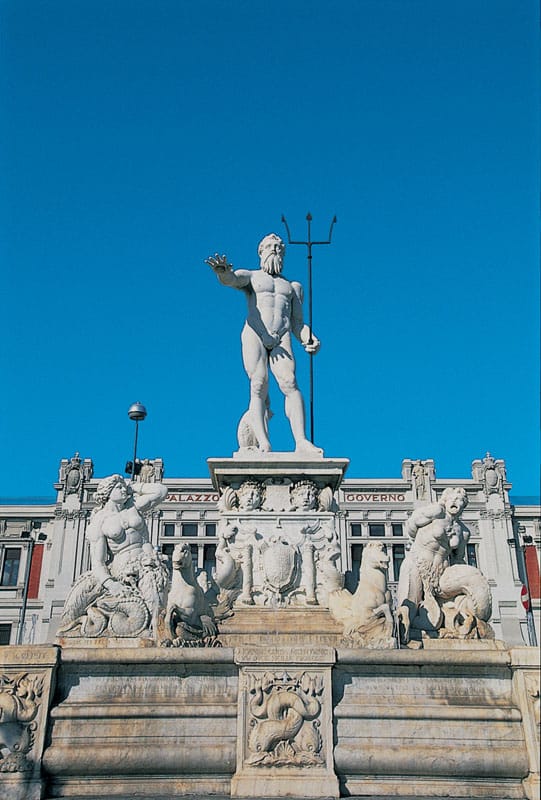
Messina's Fountain of Neptune.
Neil Buchan-Grant/APA
Piazza Antonello, just north, houses a cluster of Art Nouveau buildings leading to the vaulted Vittorio Emanuele gallery. In a neighbouring square is the small Chiesa Annunziata dei Catalani (Mon–Sat 8–11am), a sunken Arab-Norman church with Byzantine echoes. Built over a temple to Neptune, this eclectic church has Norman arches, blind arcading, 13th-century portals and honeycomb apses. The mellow stonework is often festooned with flowers: as Messina University chapel, it is much in demand for academic weddings.
Due to the earthquakes and war damage, the city churches are a wayward mixture of restoration and invention. However, Santa Maria degli Alemanni, a few blocks south of the cathedral, is an authentic roofless Gothic ruin, founded by the Order of Teutonic Knights.
Messina's magpie approach to architecture is illustrated by the neoclassical Town Hall, mock-Renaissance Chamber of Commerce, Fascistic Tribunal and Art Deco Prefecture. Contemporary churches can be Rhenish, Bavarian, Spanish or, like San Giuliano, a Byzantine pastiche. Even genuine relics are given a contemporary twist by an incongruous setting: San Francesco, a Gothic fortress of a church, overlooks a frothy ice-cream parlour.
In Piazza Unità is Montorsoli's Fountain of Neptune, but the original Renaissance sculpture lies in the Museo Regionale (Mon–Tue and Thur–Sat 9am–1.30pm, and 4–6.30pm in summer, 3–5.30pm in winter, Sun 9am–1pm; charge), on Via della Libertà. The museum mostly displays art salvaged from the 1908 earthquake, including works by Caravaggio and Antonello da Messina (1430–78), Sicily's master painter and southern Italy's greatest Renaissance artist. His moving polyptych of the Madonna with Saints Gregory and Benedict blends Flemish technique with Italian delicacy and a Sicilian sense of light. The best-preserved panel is the Madonna and Child.
Writer Rodolfo de Mattei likened the city to “a sailing ship, low in the water, ready for a night cruise”. Indeed, mercantile Messina looks romantic at night, its lights glittering along the harbour front. Summer strollers take a passeggiata from the seafront to the lively cafés on Piazza Cairoli. After dinner, under-age lovers enjoy the scenic drive up Viale Umberto to the botanical gardens.
Lido di Mortelle
In summer, city life shifts to Lido di Mortelle, a youthful resort 10km (6 miles) north of Messina. En route, the coastal road passes the Ganzirri lake, once famed for its mussel beds, now a popular place for dinner in summer, and the lighthouse of Torre del Faro on Capo Pelaro, guarding the Stretto di Messina, the narrow Straits of Messina separating Sicily from Italy's toe. This peninsula was once graced by a temple of Neptune whose columns ended up, shattered, in Messina Cathedral. Today's view is sadly marred by gigantic pylons and power cables that supply Sicily with electricity.
Over-popular Lido di Mortelle, just around the cape, offers sandy beaches and fish restaurants. As a result, the air is heavy with a peculiar combination of petrol fumes and grilled swordfish.
The Tyrrhenian coast
To get from Messina to Milazzo 41km (26 miles) away – where ferries sail to Strómboli and Lípari – either take the fast route on the autostrada A20, or, for the best scenery, follow the SS113, the old Roman road. The first stretch climbs the Monti Peloritani, winding past pine groves, broom, oleanders and geraniums. But even from the motorway are dazzling glimpses of azure inlets through the pines. On the way out of town are views of three ruined forts and apricot-coloured churches in the hills.
Tunnels thread through pine and olive groves to Milazzo 2 [map]. The vision of this verdant peninsula is slightly marred by the presence of an oil refinery. Compensations lie in the welcoming breezes and dramatic castle, with views of the jagged green spit stretching towards the Aeolian Islands. While waiting for a ferry, be tempted to sample the local swordfish or bottarga (tuna roe).
The SS113 allows panoramic views of pine forests and the Straits, particularly from Portella San Rizzo, which hugs the crest of the Peloritani range. The coastline from Messina to Palermo has been heavily fortified since Aragonese times. The headlands are still dotted with Spanish defensive towers fully exploited by the French. The Napoleonic forces boasted of being able to transmit a message to Naples in under two hours by lighting a string of fires in the coastal towers.
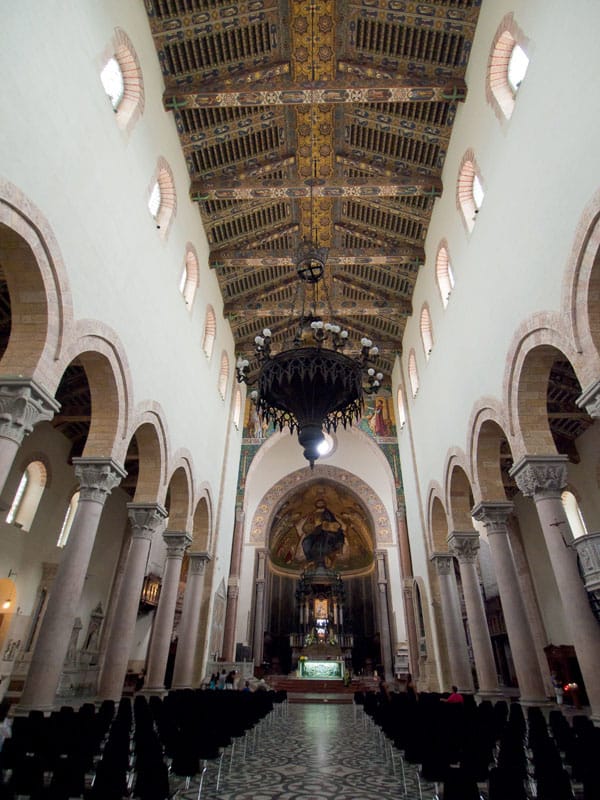
Messina Cathedral.
Neil Buchan-Grant/APA
The bridge over the Straits
The dream of building a bridge across the 3km (2-mile) Messina Straits separating Calabria from Sicily is currently just a pipedream. The Messina bridge, which would be the longest in the world, was the pet project of Silvio Berlusconi, but is currently on hold. While bridge supporters see it as a boost to the Sicilian economy, ferryboat operators, seismologists and environmentalists have long been against it, as are cynics who say the funds would only be siphoned off by the Mafia on both sides of the bridge. What's more, given the undeveloped nature of Sicily and the South, controversy rages over the wisdom of investing so much public money in a single engineering feat, with its six traffic lanes and two railway lines, when the money could be better spent on basic Sicilian infrastructure, especially roads and railways. Even on technical grounds, the project is fraught with doubts: the bridge will span a busy shipping lane and must also withstand high winds and earthquakes. Construction began in 2010, but is currently stalled while Mario Monti's technocratic government reassesses the scheme. It looks as if the Messina bridge, the final step in the unification of Italy, is still some way off.
Tip
In Milazzo, a stroll along the Al Faro promontory from the lighthouse to Capo di Milazzo leads through lush vegetation to the cape. For the energetic, a climb to the heights of Monte Trinità provides a view towards the Aeolian Islands.
Head for the walled city, passing the Baroque palaces that adorn the lower town, particularly along Via Umberto I. Here too, the Duomo Nuovo, the new cathedral, is memorable for its Renaissance paintings in the apse. Salita San Francesco, a steep stairway, climbs through the Spanish Quarter to the impressive medieval citadel, its flanks encrusted with churches. The 17th-century San Salvatore belonged to a Benedictine abbey whereas San Rocco represents an older, fortified church. San Francesco di Paola is a frescoed 15th-century shell with a Baroque facelift.
Facing the castle is the Chiesa del Rosario, once a seat of the Spanish Inquisition. This Dominican church is studded with stuccowork, an oddly fluffy vision for the rigorous interrogators.
The Castello (guided tours summer 11.30am, 4–6pm, winter 9.30–11.30am, 2.30–3.30pm; charge), perched beside a rocky precipice, occupies the site of the Greek acropolis. Erected between 1237 and 1240 and originally Arab-Norman, the citadel later fell into Hohenstaufen, Aragonese and Spanish hands. The castle's finest hour was in July 1860, when its seizure by Garibaldi's forces spelt the rout of the Royalists and the Republican conquest of Sicily. The surviving fortress is of 13th-century Hohenstaufen dynastic design with Aragonese walls. A Gothic gateway leads to the keep and parliamentary Great Hall. Also within the castle walls is the Baroque Duomo Vecchio, and the ruins of the 14th-century Palazzo dei Giurati.
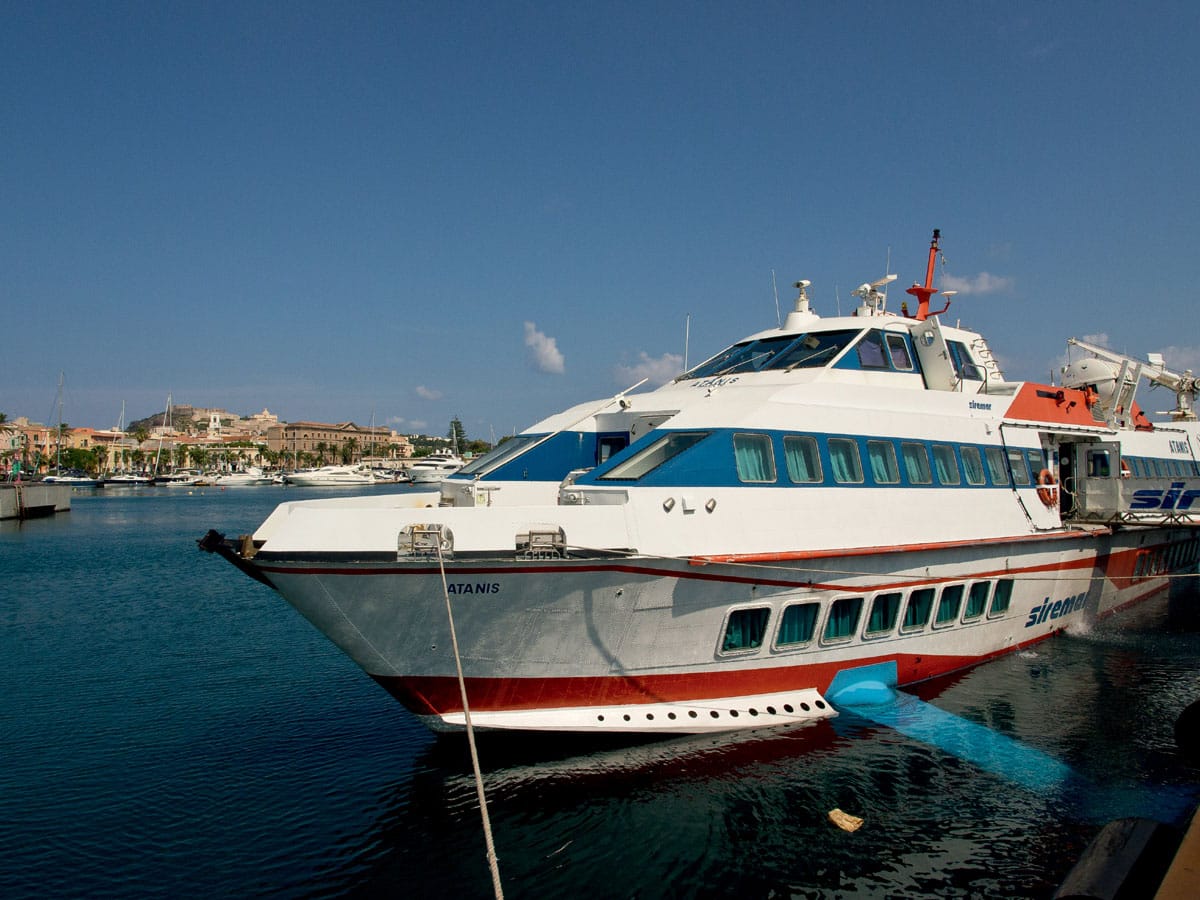
Milazzo.
Neil Buchan-Grant/APA
Boat trips to the Baia del Tono 3 [map] visit reefs, coves and grottoes, including favoured swimming spots such as the Baia San Antonio or Baia la Renella. Near the Baia del Tono is Grotta di Polifemo, Polyphemus’ cave, where Odysseus blinded the Cyclops. The 7km (4-mile) boat trip around the peninsula from Al Faro (the lighthouse) to Baia del Tono affords views of Sicily's two active volcanoes, Etna and Strómboli.
Inland excursions
If the hinterland beckons, then Santa Lucia del Mela 4 [map], 20km (12 miles) inland from Milazzo along a winding rural road, is a Saracen village with a Norman castle once on the Lombard silk route. The Norman cathedral contains a Gothic portal and an Antonello Gagini statuette of St Lucy.
Back on the SS113, take the turning south for another foray into the hinterland. Castroreale 5 [map], a shabby upland village, was founded by the Siculi in the 8th century BC. Although the settlement flourished as a medieval barony, a ruined tower is all that remains of Frederick II's summer home.
The fertile coastal plain around Castoreale abounds in vineyards, olive plantations and orange groves, while the neighbouring coastal town of Castroreale Terme appeals to thermal spa enthusiasts. An inland road from Castoreale Terme leads to the archaeological site of Longane 6 [map] (9am–one hour before sunset), near Rodi. Set on the edge of the Peloritani mountains, this megalithic and Sikel settlement was razed by Messina in the 5th century BC. The remains of a turreted fort are visible, and there are Bronze Age cavity tombs in the nearby necropolis. From Rodi, join the SS185 as if returning to the coast.
Just before Castroreale Terme lies the Roman site of San Biagio 7 [map], a Roman villa built in the 1st century (daily 9am–one hour before sunset; charge). The baths feature a black and white mosaic of fishermen and dancing dolphins.
The SS113 takes you westwards to Oliveri 8 [map] and a chance to exchange churches for seafood and excellent beaches. Between here and Cefalù is arguably the cleanest stretch of coastline on the island. Oliveri itself is a standard Sicilian resort with a Norman-Arab feudal castle and sandy beaches. On the seafront is a converted tonnara, the traditional tuna fishery, a reminder of life before tourism.
Oliveri is on the Golfo di Patti, a wilder spot than the Gulf of Milazzo, stretching west to the rocky ridges of Capo Calavà. Its bays are framed by the moody Nebrodi mountains. The coastal road crosses fiumare, wide, dry torrent-beds, and overlooks World War II pillbox defences.
Tindari
Dominating the Capo Tindari headland is Tindari 9 [map], formerly Tyndaris, one of the last Greek colonies established in Sicily, founded by Dionysius in 396 BC. Pliny records that in AD 70 much of the city slipped into the sea. Despite subsidence and earthquake, the Graeco-Roman city prospered until razed by the Arabs in 836.
The Santuario della Madonna Nera (summer 6.45am–12.30pm, 2.30–8pm, winter 6.45am–12.45pm, 2.30–7pm) stands on the site of an ancient acropolis. The glittering sanctuary is revered all over southern Italy as a shrine to a black-faced Byzantine icon with miraculous powers. The seated 16th-century Madonna Nera bears the motto: Nigra sum, sed hermosa (I am black, but beautiful). Among other miracles, she is credited with causing the sea to withdraw to provide a magic mattress of sand to cushion a child's fall over the cliff.
Celebrating the Black Madonna, the Santuario della Madonna Nera is a contemporary effusion of kitsch beloved by Sicilians who make pilgrimages throughout the year, particularly on the Madonna's feast day, 8 September. The A20 autostrada exit is just 8km (5 miles) away, and Messina only 65km (40 miles).

Santuario della Madonna Nera.
Neil Buchan-Grant/APA
The archaeological park (daily 9am–two hours before sunset; charge) is pleasingly wild. Italian visitors, of course, are more impressed by the sacred Black Madonna housed in the church bordering the park. The Greek city covers a Bronze Age site and has left its mark in impressive boundary walls (3rd century BC) and assorted public buildings. The Graeco-Roman theatre cannot compare with Taormina's but enjoys a superb natural setting overhanging the bay. Classical drama, concerts and opera are now performed here in summer. A wide thoroughfare, one of three original decumani, links the theatre to the vaulted basilica. This Augustan basilica was once a grand entrance to the agora, a ceremonial space for meetings and festivals. Nearby are the remains of Roman baths, villas, workshops and taverns. One villa is adorned with geometrical mosaics, while the thermal baths enclose mosaics of dolphins, bulls, warriors and the Trinacria, the symbol of Sicily. The on-site antiquarium displays sculptures, ceramics, a tragic mask and a bust of Augustus.
Sailors entering the Straits of Messina were wary of the twin demons of Scylla, a female six-headed sea monster, and Charybdis, a whirlpool. In reality, these were clashing currents meeting in the Straits. Although the sea's flow was diverted after the 1908 earthquake, strange counter-currents still exist, colourfully known as“bastardi”.
Below Cape Tindari is the Oliveri lagoon, one of Sicily's loveliest natural havens. Migratory birds, including grebes, coots and egrets, are drawn to the pale-green saltwater pools and wide beaches of translucent grey pebbles. The lagoon's sands are a sublime spot for a picnic of fresh bread and local caciocavallo cheese.
Patti ) [map], set on a low hill facing the sea, was damaged in the 1978 earthquake but the medieval quarter, linking Via Ceraolo and the cathedral, has a quiet charm and several art-filled churches. The remodelled cathedral is home to remarkable treasures: a subtle Madonna by Antonello da Saliba and the Renaissance sarcophagus of Queen Adelasia, Roger I's wife, complete with the original Norman effigy.
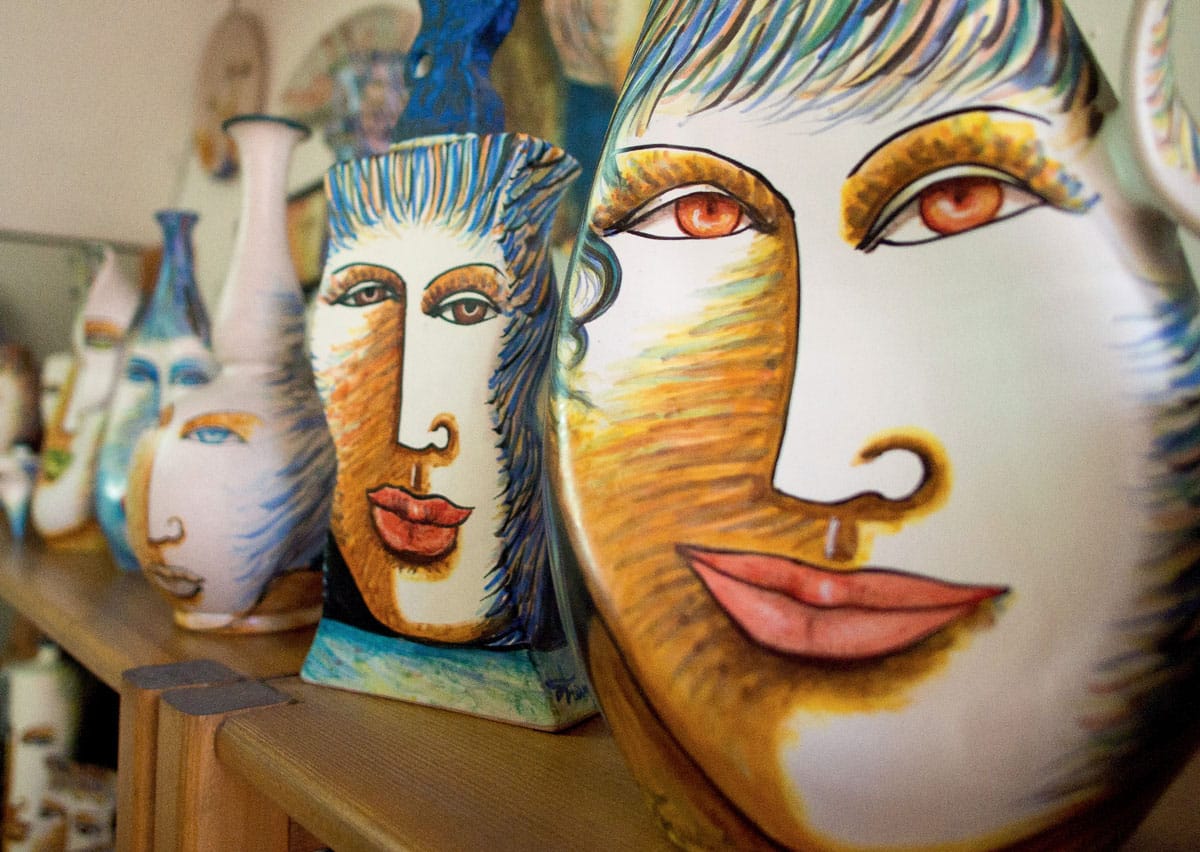
Santo Stéfano di Camastra ceramics.
Neil Buchan-Grant/APA
Sadly, this historic hill town is ringed by a jagged necklace of new development. Even so, Patti has recently unearthed its greatest attraction, a Roman villa (daily 9am–one hour before sunset; charge) at Marina di Patti. This sumptuous late Imperial villa was destroyed by an earthquake in AD 4 but restored and then occupied until Byzantine times. After centuries of oblivion, it was rediscovered during the construction of the motorway in 1973. The gracious rooms lead off a porticoed peristyle, looking incongruous beside the motorway flyover. The mosaics display geometric, animal, figurative and floral motifs, often of African inspiration. But Patti suffers from wilful neglect.
After a surfeit of art and architecture, picnic among the poppies, as the Roman aristocracy did, or retreat to the beaches of Marina di Patti.
Forays inland
On the road from Patti to Capo d'Orlando are a cluster of resorts fighting a battle against coastal ribbon development and Mafia influence, currently losing the former but winning the latter. On the Capo's promontory, reached by a hard climb, are the remains of a medieval castle and the sanctuary of Santa Maria di Capo d'Orlando, erected in 1598.
From the sandy resort of Gioiosa Marea ! [map], walk up to the ghost town of Gioiosa Vecchia, abandoned after an 18th-century landslide. Brolo, just west, has a crenellated Saracen tower and crumbling city walls, but Sicilians come here for the fish soups, squid dishes and salami from the hills behind Brolo.
A rural foray inland visits Raccuja, Tortorici and Castell'Umberto, a case of the journey being more pleasurable than the destination. Citrus groves give way to pine forests and steep ridges, with stunning views from the hilltop villages to the Aeolian Islands. A tortuous inland road leads from Brolo to Raccuja. In winter, continue south along the SS116 to the ski resort of Floresta. Heading back to the coast from Floresta, turn off left to visit a couple of villages before returning to Capo d'Orlando. Tortorici @ [map] is traditionally associated with the Mafia, but has several fine churches and school of Gagini sculptures.
About 10km (6 miles) north along switchback roads is Castell'Umberto £ [map], a former feudal domain with a long Dominican tradition. Constant landslides persuaded the citizens to abandon the centro storico, even if it still has a whimsical charm, with its ruined castle and vine-hung churches.
Capo d'Orlando and west
Capo d'Orlando $ [map] is a windswept headland subject to sudden storms. Set on the edge of a fertile plain, this sprawling resort offers a sandy beach strewn with whale-shaped boulders, or a climb to the ruined medieval castle and church perched on the cape.
Sant'Agata di Militello % [map], the first significant resort west of Capo d'Orlando, is known for its promenades, popular pebbled beach and seafood, with the local castle turned into a restaurant.
Pottery fans can follow the SS113 west to Santo Stéfano di Camastra ^ [map], one of Sicily's main ceramics centres. Lining the roadside, the piles of pottery make purchase a mere formality.
From here, the enchanting SS117 road leads 16km (10 miles) inland across the Nebrodi range to Mistretta & [map], a rust-coloured town commanding a ridge. With its ruined feudal castle, sculpted Chiesa Madre (1630), red-tiled houses and cobbled streets, the town has a faded charm.
Castel di Tusa * [map], which borders Palermo Province, is noted for its ruined castle, rocky beach and eclectic avant-garde hotel, the Atelier sul Mare (tel: 0921 334 295; www.ateliersulmare.it).
Inland is the pretty town of Tusa, and access to the Greek site of Halaesa (9am–one hour before sunset), a city founded in 5 BC. Remains include the agora, boundary walls, theatre and temple.
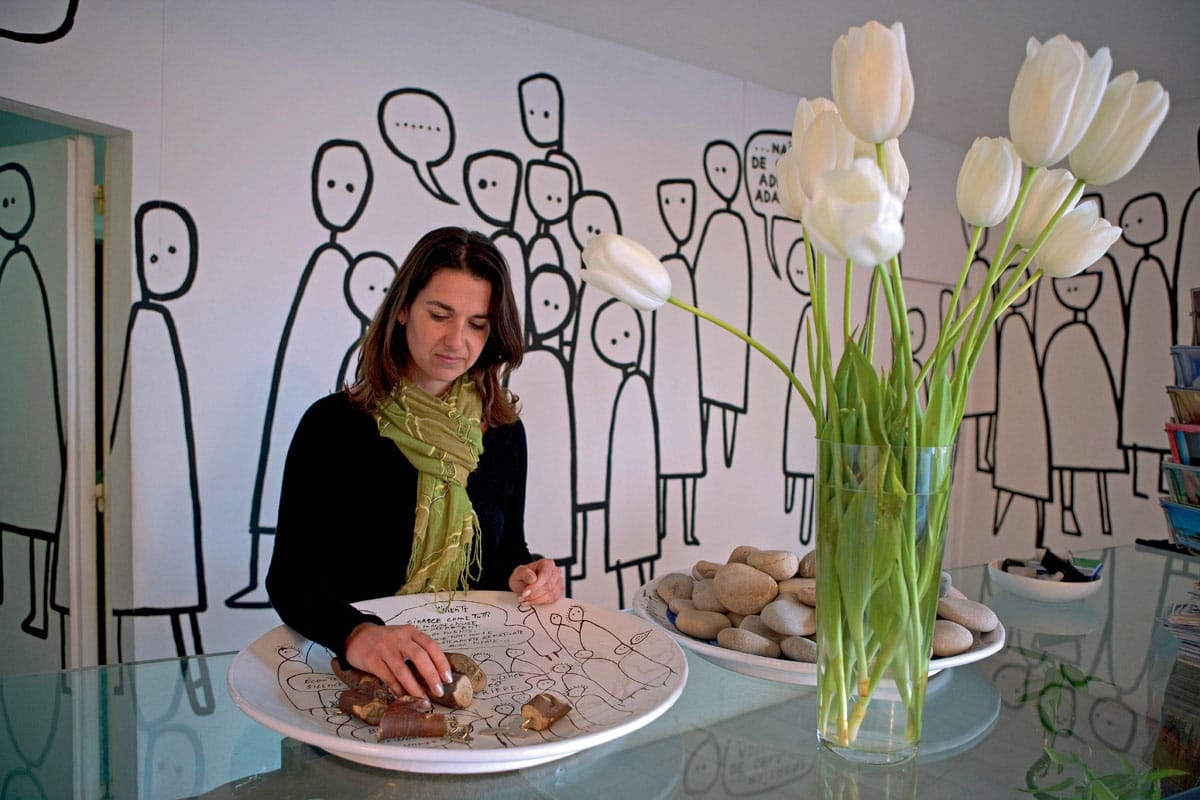
Reception at Atelier sul Mare, Castel di Tusa.
Neil Buchan-Grant/APA
Tip
The Festa dei Giudei is a unique annual Easter event at San Fratello. Men and women dress up as Giudei (Jews) in bright red jackets and hose, covered with Arab ornament. They carry trumpets and wear grotesque masks. This is by no means anti-Semitic. It is assumed the tradition started in order to poke fun at the Jewish role in the Catholic ritual of the Easter Passion, but now it is just an occasion for making merry.
Monti Nebrodi
A rural drive through the wooded hinterland of the Nebrodi mountains takes you into remote, rugged hill-walking country. For an adventurous trail, try the circuit around the Parco Regionale dei Nebrodi, starting anywhere between Patti and Sant'Agata di Militello, where road signs indicate the Parco and San Fratello.
San Fratello ( [map], 18km (11 miles) from the coast, is one of the most evocative Nebrodi villages and is particularly colourful during its famous demonic Easter festival, the Feast of the Jews, Festa dei Giudei, a shrieking costumed chase. It is not so much anti-Semitic as Sicilian, hence a sacrifice of subtlety to spectacle. This scenic mountain village has a Norman church and a 15th-century Franciscan monastery. Horse-breeding has always played a big part in community life here, and each September Arab horses are put through their paces in the village.
Further along, the SS289 snakes through rugged terrain to Cesarò , [map], where on 15 August they, too, celebrate horses in the Palio dei Nebrodi. This village of shepherds also has a ruined castle, destroyed during a battle between feuding dynasties in 1334.
Exploring Monti Nebrodi
The rounded silhouettes of the Nebrodi offer vistas of rocky outcrops or rolling hills covered in oak and beech woods or rough pasture. Compared with the Madonie range, the Nebrodi mountains are less accessible: exploration is necessarily slow, since the lack of east–west roads frequently means retracing one's steps to the coast. Before Cesarò, as you climb the range, Portella Fèmmina Morta offers a detour on foot or with an off-road vehicle to Monte Soro, the highest point in the Nebrodi at 1,847 metres (6,060ft), with fabulous views, a lake, thick woods and wildlife that includes falcons, eagles, herons, or even wild cats and wolves. Near fresh water, look out for wild fowl, the Sicilian marsh tit, and the wonderfully named Tachybaptus ruficolis. The name means “fast-bathing red stomach”, an apt description of the little grebe. As a base, the most typical Nebrodi village is arguably the strange San Fratello (Parco dei Nebrodi, www.parcodeinebrodi.it).
From Portella Fèmmina Morta ⁄ [map], before Cesarò, hikers can reach the lofty Monte Soro, the highest point in the Nebrodi at 1,847 metres (6,060ft), or adventure-seekers can opt for an off-road tour. Here, too, is the Lago Biviere di Cesarò, an ancient lake that turns bright pink with algae in the hotter months, and a spot popular with migratory storks and the marsh turtle.
At Cesarò an appealing detour of 20km (12 miles) along the SS120 leads to Troìna ¤ [map], at 1,120 metres (3,675ft) the highest town in Sicily. This panorama of hills and valleys was once enjoyed by prehistoric man. Still visible are the remains of ancient Greek walls, while the Chiesa Madre has a fine 16th-century campanile and medieval Madonna and Child.
To complete the Nebrodi circuit, from Cesarò the SS120 leads to Abbazia di Maniace, Admiral Nelson's home and on to Randazzo, where the Sunday morning market displays Nebrodi crafts; then to Floresta, and after some breathtaking bends, back down to Patti and the coast. The complete circuit is about 230km (143 miles).
Messina's Ionian coast
This narrow coastal strip is characterised by a contrast between the barren slopes of the Monti Peloritani (highest point 1,374 metres/4,500ft) facing the shore and the wooded slopes facing inland. As you travel south, there are architectural contrasts between the Baroque or modern coastal towns and the medieval settlements in the hilly hinterland.
From Messina, the motorway hugs the shore south for 52km (32 miles) from the narrow Straits of Messina to Taormina ‹ [map], hemmed in by mountains.
If travelling on the A18 motorway, at Santa Teresa di Riva leave the coastal crowds for mountain air and curious hamlets. Despite the proximity of Taormina, this is timeless Sicily, as remote as anywhere on the island. The scenery is stark: skeletal peaks and brooding ravines; mountains gouged by winter torrents and scorched brown in summer. Such fierceness is softened by sweet-scented scrub and the curves of Moorish monasteries.
Sávoca
Just inland is the battered mountain village of Sávoca › [map], best known for its macabre mummies, embalmed in a crypt by local monks, and for its associations with The Godfather.
The catacombs of the Cappuccini monastery (variable, tel: 349 425 4398; donation) contain 32 ghoulish mummified corpses dating from the 17th century. At a time when corpses were thrown into the communal ditch, genteel mummification was a tradition among noble families. The bodies were drained, sprinkled with salt and left to dry for a year before being washed in vinegar, aired and then dressed in their original clothes. These gruesome, wizened faces and shrunken puppet-like forms are mummified abbots, lawyers, noblemen and priests. Now run by a religious association, this spartan former monastery accepts guests in its un-ghoulish rooms.
Robert de Niro, who starred inThe Godfather II, said of Sicilians: “Ultimately, everyone else is a foreigner. Suspicion runs high. And although they are very cordial to you as a tourist, you are still aware of this. Sicilians have a way of watching without watching; they'll scrutinise you thoroughly and you won't even know it.”

Sávoca.
Neil Buchan-Grant/APA
After this macabre scene, leave the monastery for the evocative medieval village, a former Saracen stronghold. Sávoca's name derives from sambuca, not the famed Italian liqueur, but the elder trees that still perfume the hills. A paved path climbs cacti-dotted terraces and olive groves to the village, a scene embracing churches overgrown with prickly pear, a tumbledown dovecote, and terraces slipping into the sea. The church of San Niccolò lost its choir in a landslide but kept its dignity, while the Chiesa Madre retains the charm that caught Coppola's eye for The Godfather. This solitary church, on a narrow ridge overlooking the sea, was renovated with film money. The scruffy Bar Vitelli, immortalised in Michael Corleone's wedding banquet, comfortably hosts peasants and borghesi, united in their thirst for a cool granita di limone (lemon sorbet).
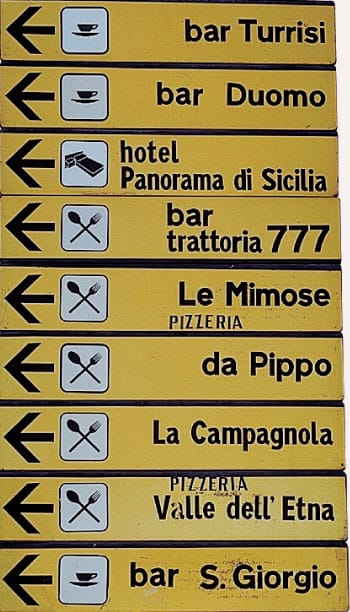
Tourist signs.
Glyn Genin / APA
Casalvécchio Sículo, charmingly set above Sávoca, is livelier but less complex, with a gilded parish church and windswept views over terraces. On the outskirts of the village, take the first turning left, a steep road signposted to SS Pietro e Paolo d'Agro fi [map], a monastic church down in the Val d'Agro. Despite its desolate location on the bank of the dry Agro river, this is the most significant Arab-Norman church in eastern Sicily. The twin-domed exterior is reminiscent of a Turkish mosque. A banded facade combines red brick, black lava, cool limestone and grey granite. Restored in 1171, the church is a synthesis of Byzantine and Norman styles. Moorish roundness and decorative flourishes compete with Norman verticality and austerity.
Giardini-Naxos
Before ascending to Taormina, consider neighbouring Giardini-Naxos fl [map], Sicily's first Greek colony. It was founded (as Naxos) on an ancient lava flow by Euboeans in 735 BC and became a springboard for colonisation of Catania and the east coast. But after supporting Athens against Siracusa, the colony was destroyed by Dionysius in 403 BC.
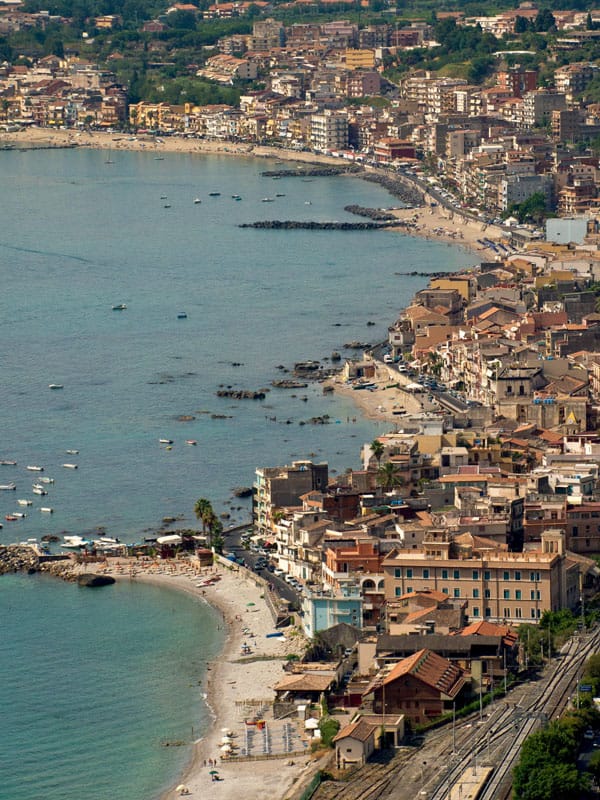
Giardini-Naxos.
Neil Buchan-Grant/APA
The archaeological site (daily 9am–one hour before sunset; charge) occupies the promontory of Capo Schiso (follow signs for scavi, excavations). A stretch of Greek lava-stone city walls remains, but the elusive Temple of Aphrodite is still being excavated, as are some villas. The small museum displays Greek, Roman and Byzantine finds, including a head of Silenus, god of fertility and wine.
Lemon groves are giving way to ribbon development, for Giardini-Naxos is Sicily's fastest-growing beach resort, as is neighbouring Letojanni ‡ [map]. Still, for the young crowd there are compensations: cheap and cheerful trattorie, wide beaches fringed by volcanic rocks and a riotous nightlife that Silenus might have enjoyed. Moreover, unlike Catania province, this stretch of coast offers sandy, rocky or pebbled shores, with an abundance of free and private beaches.
The Godfather's Sicily
The Godfather is still big business in Sicily. After Mount Etna, it remains the most popular excursion from Taormina. The typical tour whisks visitors to Sávoca, where The Godfather was filmed. Francis Ford Coppola found his perfect setting in its dusty piazza, the windswept church, the shots of Etna smouldering in the distance and the shimmer of the Ionian Sea. Follow in Al Pacino's footsteps by stopping for a lemon granita in the battered Vitelli bar. Then admire Santa Lucia, where the wedding scene between Apollonia and Michael was shot. The tour continues to Forza d'Agro, one of the loveliest medieval villages in Sicily, with panoramic views. (Book through Taormina agencies, such as Sicily Life, www.sicilylife.com.)
Best Restaurants, Bars and Cafés
Messina
Al Padrino
Via Santa Cecilia 54
Tel: 090 292 1000 €€
This inexpensive trattoria is a good place to sample regional specialities; try the house dish, melanzane al Padrino (aubergine stuffed with pasta and ricotta). Closed Sat dinner and Sun.
Da Bacco
Via Cernaia 15
Tel: 090 771 420 €€
Hostaria with good range of seafood. Closed Sun.
Davai
Via XXVII Luglio 36
Tel: 090 293 4865 €€€
Welcoming restaurant based on the old Teatro Savoia serving cucina messinese, the best of Messina-style dishes. Closed Mon.
Le Due Sorelle
Piazza Municipio 4
Tel: 090 44720 €€
A long-established but modernised trattoria. Good wines and simple cooking. Book. Closed Sat lunch and Sun.
Gambero Rosso
Via Consolare Pompea
Tel: 090 393 873
www.ilgamberorossomessina.it €€
Good, inexpensive. Fish, mostly. Closed Tue. Osteria del Campanile
Via Loggia dei Mercanti 7
Tel: 090 711 418
www.osteriadelcampanile.com €€
Behind the Duomo, this simple restaurant has a good range of pasta dishes, as well as crispy pizzas. Closed Sun except summer.
Shawarma
Via MGiurba 8
Tel: 090 712 213 €
A welcome break from Italian cuisine, this restaurant serves up North African specialities such as tagines and couscous. Closed Mon.
Trattoria del Popolo
Piazza del Popolo 30
Tel: 090 671 148 €€
An appealing restaurant with outdoor tables and seafood specialities such as squid in breadcrumbs. Closed Sun.
Capri Leone, Messina
Antica Filanda
Contrada Raviola
Tel: 0941 919 704
Overlooking the Aeolian Islands, this restaurant focuses on produce and dishes from the Nebrodi mountains. Expect black Nebrodi pork, Montalbano provola cheese, ricotta and Nebrodi goats’ cheeses. Closed Mon and mid Jan to mid-Feb.
Milazzo
Al Castello
Via Federico di Svevia 20
Tel: 090 928 2175 €€€
A charming place to be in summer when tables are outside, lit by the floodlights on the walls of the Castello. Sicilian cooking. Closed Tue.
Al Pescatore
Via Marina Garibaldi 176
Tel: 090 928 6595 €€
Popular trattoria known for its seafood served at reasonable prices. Decorated to match its passion for fish. Closed Thur.
Covo del Pirata
Via San Francesco 2
Tel: 090 928 4437
Cucina messinese served in rooms decorated with a marine theme. Closed Wed.
La Casalinga
Via D'Amico 13
Tel: 090 922 2697 €€
A fish specialist; the house dish is spaghetti with crab sauce. Closed Sun dinner Oct–June.
Piccolo Casale
Via Riccardo d'Amico 12
Tel: 090 922 4479
Discreet trattoria, elegant and with flowery terrace. A favourite with locals. Dinner only. Closed Jan and Aug.
Letojanni
Da Nino
Via Rizzo 29
Tel: 0942 36147
www.danino.it €€€
Warm and welcoming hotel/restaurant in a charming location. Lots of fresh fish dishes.
Peppe
Via Vittorio Emanuele 346
Tel: 094 236 159
Old-style trattoria, part of 45-room hotel. Simple fare. Sicilian dishes. Closed Nov–Feb.
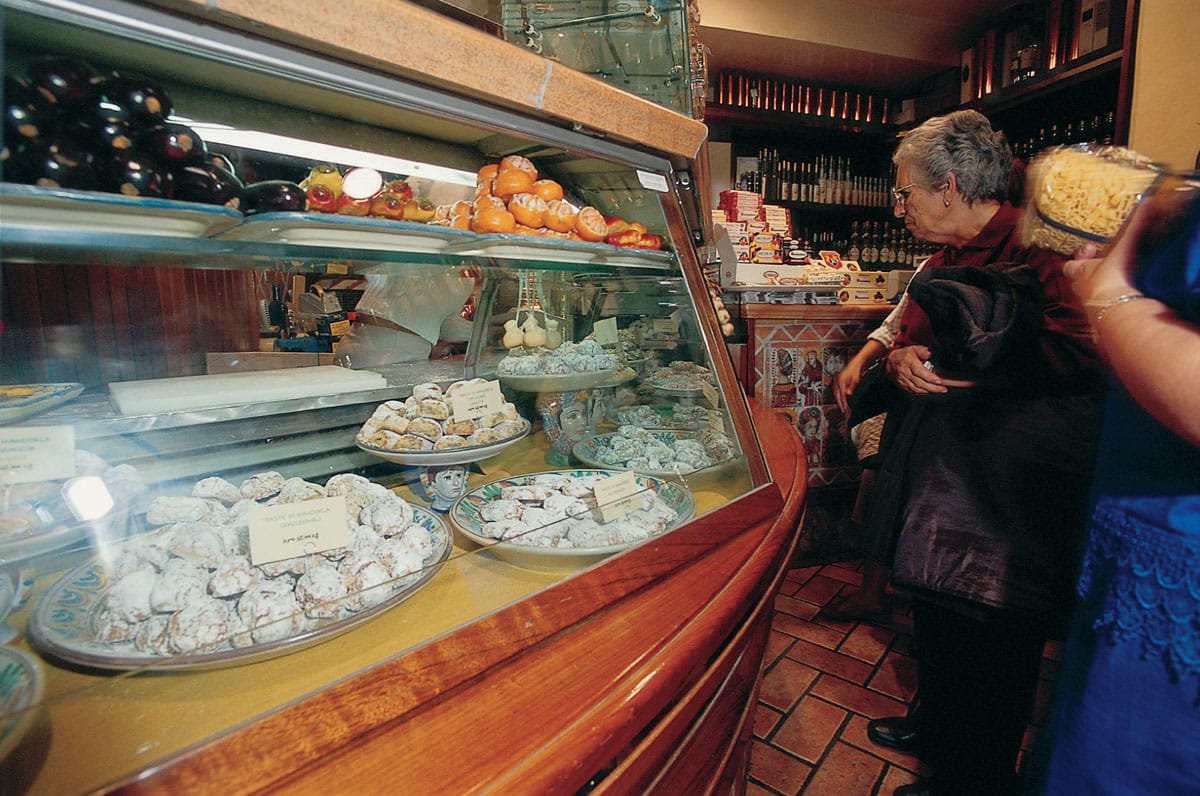
Sicilians have a sweet tooth.
Gregory Wrona/APA
